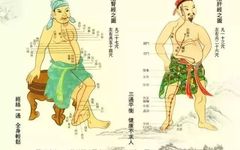

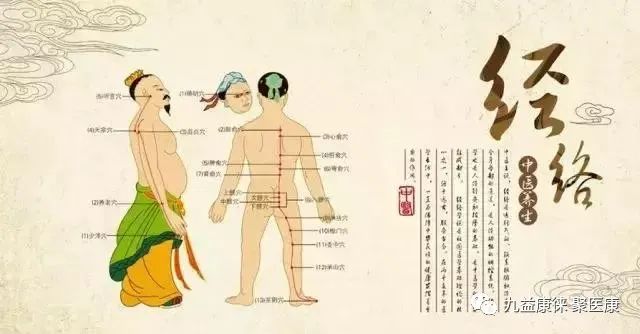
The Eight Extraordinary Meridians (qí jīng bā mài) are a category of the body’s meridian pathways. They include the Du Mai (Governing Vessel), Ren Mai (Conception Vessel), Chong Mai (Penetrating Vessel), Da Mai (Belt Vessel), Yang Wei Mai (Yang Linking Vessel), Yin Wei Mai (Yin Linking Vessel), Yin Qiao Mai (Yin Heel Vessel), and Yang Qiao Mai (Yang Heel Vessel). Unlike the twelve regular meridians, they do not directly connect to the organs and do not have a paired relationship, hence they are referred to as “extraordinary meridians”.
What are the Eight Extraordinary Meridians?
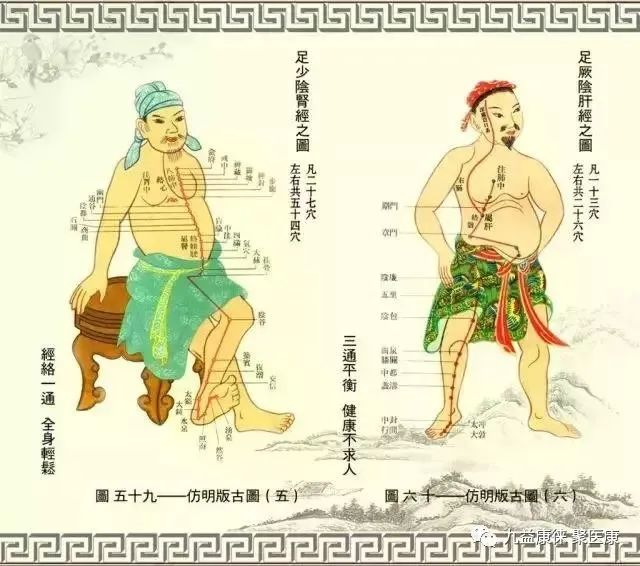
1
Extraordinary Meridians
The Eight Extraordinary Meridians consist of the Ren Mai, Du Mai, Chong Mai, Da Mai, Yin Qiao Mai, Yang Qiao Mai, Yin Wei Mai, and Yang Wei Mai. They differ from the twelve regular meridians as they do not directly connect to the organs and do not have a paired relationship, thus they are termed extraordinary meridians.
Functions:
1. Facilitate communication between the twelve meridians;
2. Regulate the accumulation and distribution of qi and blood in the twelve meridians.
2
Eight Meridians
1. Ren Mai: Runs along the midline of the abdomen, frequently intersecting with the three Yin meridians of the hands and feet as well as the Yin Wei Mai, thus it is known as the “Sea of Yin Meridians”. The Ren Mai originates in the uterus and is associated with pregnancy, hence it is said to “govern the uterus and fetus”.
2. Du Mai: Runs along the midline of the back, frequently intersecting with the three Yang meridians of the hands and feet as well as the Yang Wei Mai, thus it is known as the “Sea of Yang Meridians”. The Du Mai runs along the spine, ascends into the brain, and branches off to connect with the kidneys, establishing a close relationship with the brain, spinal cord, and kidneys.
3. Chong Mai: Ascends to the head and descends to the feet, traversing the entire body; it serves as a crucial point for qi and blood, regulating the qi and blood of the twelve meridians, hence it is referred to as the “Sea of the Twelve Meridians” and also known as the “Sea of Blood”. It is related to women’s menstruation.
4. Da Mai: Originates from the lateral abdomen, descends diagonally to the Da Mai point, encircling the body like a belt, thus it can restrain the meridians that run vertically.
5, 6. Yin Qiao Mai, Yang Qiao Mai: The term “Qiao” implies agility and quickness. They are responsible for nourishing the eyes, controlling eyelid movement, and lower limb movement.
7, 8. Yin Wei Mai, Yang Wei Mai: The term “Wei” implies connection. The function of the Yin Wei Mai is to “connect all Yin meridians”; the function of the Yang Wei Mai is to “connect all Yang meridians”.
Physiological Functions of the Eight Extraordinary Meridians
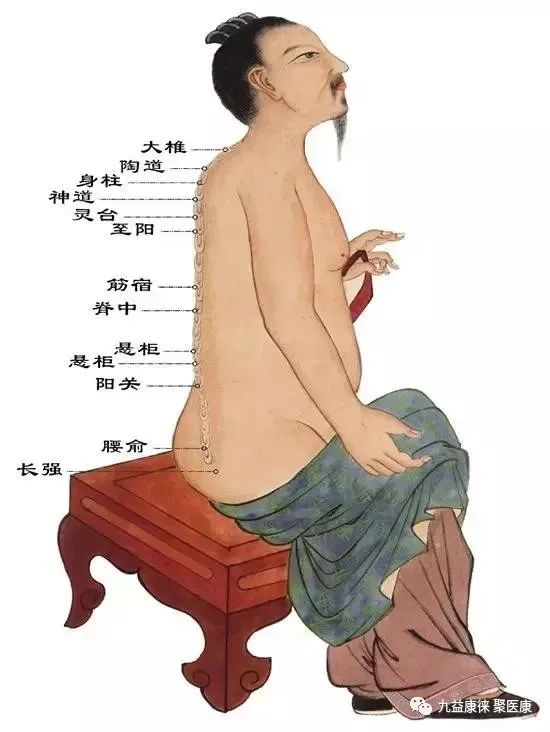
2. Regulate the qi and blood of the twelve meridians: When the qi of the twelve meridians is abundant, it is stored in the Eight Extraordinary Meridians; when the qi and blood of the twelve meridians are insufficient, the Eight Extraordinary Meridians “overflow” to provide timely supplementation.
3. The Eight Extraordinary Meridians have a close relationship with the liver, kidneys, and other organs, as well as with the uterus, brain, and marrow, establishing physiological and pathological connections.
The Pathways and Physiological Functions of the Eight Extraordinary Meridians
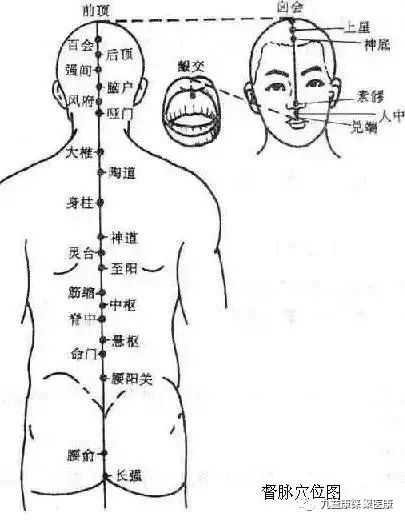
1
The Pathway and Physiological Functions of the Du Mai
1. Pathway: The Du Mai originates in the lower abdomen, exits at the perineum, travels to the tailbone at the Changqiang point, ascends along the spine, passes through the nape to the Fengfu point, enters the brain, belongs to the brain, ascends along the midline of the head to the Baihui point, descends through the forehead to the Suliao point at the tip of the nose, passes through the philtrum, and reaches the Gingjiao point at the center of the upper gums.
2. Branches: The first branch, along with the Chong and Ren meridians, originates in the uterus, exits at the perineum, and meets the qi of the Kidney meridian and the Bladder meridian at the tailbone, traversing the spine and belonging to the kidneys. The second branch ascends directly from the lower abdomen through the navel, travels upward to the throat, intersects with the Chong and Ren meridians, and reaches the lower jaw, encircling the lips and arriving at the center below the eyes. The third branch, originating from the inner corner of the eye along with the Bladder meridian, ascends to the forehead, intersects at the top of the head, connects to the brain, and then branches down the back of the neck, along the inner scapula, beside the spine, reaching the waist, and entering the muscles on both sides of the spine, connecting with the kidneys.
3. Physiological Functions
(1) Regulates the qi and blood of the Yang meridians, serving as the “Sea of Yang Meridians”: The Du Mai runs along the back, which is Yang, indicating its role in overseeing and regulating the qi of all Yang meridians. Additionally, all six Yang meridians intersect with the Du Mai at the Dazhui point, demonstrating its regulatory function over Yang meridians, hence it is said to “govern all Yang meridians”.
(2) Reflects the functions of the brain, kidneys, and spinal cord: The Du Mai belongs to the brain and connects with the kidneys. The kidneys produce marrow, and the brain is considered the sea of marrow. The relationship between the Du Mai, brain, kidneys, and spinal cord is very close.
(3) Governs reproductive functions: The Du Mai connects with the kidneys, and since the kidneys govern reproduction, the Du Mai is related to reproductive functions.
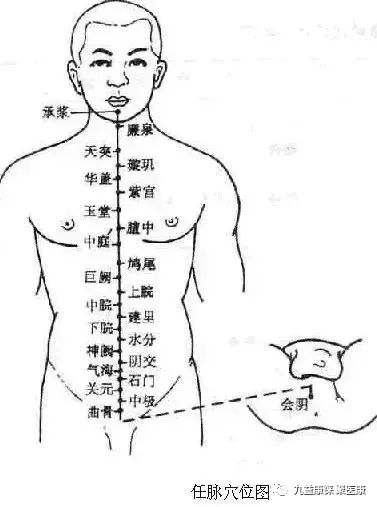
2
The Pathway and Physiological Functions of the Ren Mai
1. Pathway: The Ren Mai originates in the uterus, exits at the perineum, travels through the Yinfu, ascends along the midline of the abdomen, passes through the throat (Tiantu point), and reaches the inner lower lip, dividing to encircle the lips, intersecting with the Du Mai at the Gingjiao point, and then passing through the sides of the nose, ascending to the lower eye socket (Chengqi point), where it intersects with the Yangming meridian of the foot.
2. Branches: It traverses the spine from the uterus, ascending along the back.
3. Physiological Functions
(1) Regulates the qi and blood of the Yin meridians, serving as the “Sea of Yin Meridians”: The Ren Mai runs along the midline of the abdomen, which is Yin, indicating its role in overseeing and regulating the qi of all Yin meridians. Additionally, the three Yin meridians of the foot intersect with the Ren Mai in the lower abdomen, and the three Yin meridians of the hand connect with the Ren Mai through the three Yin meridians of the foot, thus the Ren Mai regulates the qi and blood of the Yin meridians, hence it is said to “govern all Yin meridians”.
(2) Regulates menstruation and supports fetal development: The Ren Mai originates in the uterus, playing a role in regulating menstruation and promoting female reproductive functions, hence it is said to “govern the uterus and fetus”.
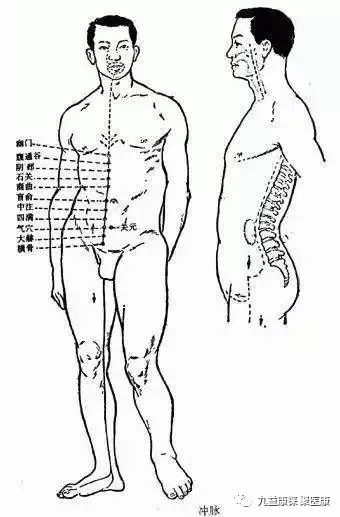
3
The Pathway and Physiological Functions of the Chong Mai
1. Pathway: It originates in the uterus, exits at the perineum, and divides into two branches. The ascending branch (the main trunk of the Chong Mai) runs along the anterior abdominal wall, near the navel (five fen beside the navel), ascends, intersects with the Kidney meridian, spreads in the chest, and then ascends through the throat, encircling the lips; the descending branch runs along the posterior abdominal wall, ascending within the spine. The descending branch exits the perineum and descends along the inner thigh to the big toe.
2. Physiological Functions
(1) Regulates the qi and blood of the twelve meridians: The Chong Mai ascends to the head and descends to the feet, traversing the entire body, serving as a crucial point for the qi and blood of all meridians. When the qi and blood of the meridians and organs are abundant, the Chong Mai can store and accumulate them; when they are insufficient, the Chong Mai can provide infusion and supplementation to maintain the normal physiological activities of the body’s tissues and organs. Hence it is referred to as the “Sea of the Twelve Meridians”, “Sea of the Five Zang and Six Fu”, and “Sea of Blood”.
(2) Governs reproductive functions: The Chong Mai originates in the uterus, also known as the “Blood Chamber” or “Sea of Blood”. The Chong Mai has a role in regulating menstruation. It is closely related to reproductive functions; for women, “when the Chong Mai is abundant, menstruation occurs regularly, leading to conception”. Conversely, if the Chong Mai is deficient, it can lead to reproductive dysfunction.
(3) Regulates the ascending and descending of qi: The Chong Mai connects with the Kidney meridian, belongs to the Yangming, and connects with the Jueyin and Taiyang. The Chong Mai has the function of regulating the ascending and descending of qi in certain organs (mainly the liver, kidneys, and stomach).
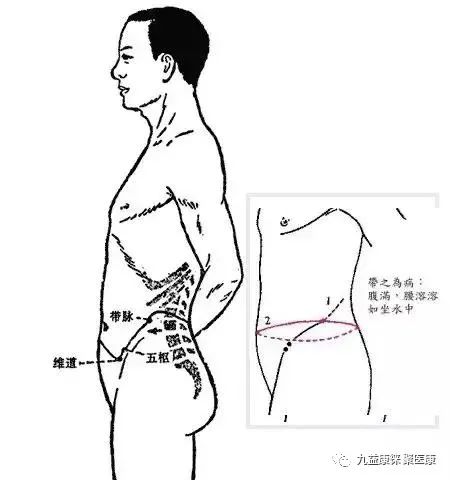
4
The Pathway and Physiological Functions of the Da Mai
1. Pathway: The Da Mai originates from the lateral abdomen, descends diagonally, intersects at the Da Mai point of the Gallbladder meridian of the foot, encircles the body, and then descends forward along the upper edge of the hip bone to the lower abdomen.
2. Physiological Functions: It restrains the vertical meridians and governs women’s leukorrhea.

5
The Pathway and Physiological Functions of the Yin Qiao Mai
1. Pathway: The Yin Qiao Mai originates from the inner side of the heel of the foot, at the Zhaohai point of the Kidney meridian, ascends through the inner ankle, along the inner thigh to the anterior genital area, ascends along the anterior trunk to the chest, enters the Qiaoban, ascends beside the Adam’s apple to the Ren Mai, and reaches the side of the nose, connecting with the inner corner of the eye, and ascending with the Taiyang and Yang Qiao Mai.
2. Physiological Functions: It controls the opening and closing of the eyes and the movement of muscles.

6
The Pathway and Physiological Functions of the Yang Qiao Mai
1. Pathway: The Yang Qiao Mai originates from the outer side of the heel of the foot, at the Shenshu point of the Bladder meridian, ascends along the outer ankle, travels up the outer edge of the lower limb to the abdomen, along the posterior outer side of the chest, through the shoulder, along the outer side of the neck, reaching the corner of the mouth, and arriving at the inner corner of the eye. It connects with the Bladder meridian and the Yin Qiao Mai, then ascends along the Bladder meridian to meet the Shaoyang meridian at the Fengchi point behind the neck.
2. Physiological Functions: It controls the opening and closing of the eyes and muscle movement.
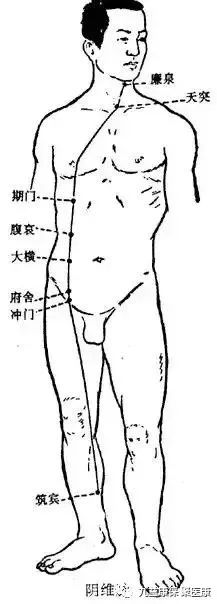
7
The Pathway and Physiological Functions of the Yin Wei Mai
1. Pathway: The Yin Wei Mai originates from the Zhubin point of the Kidney meridian, located five cun above the inner ankle, ascends along the inner edge of the lower limb to the abdomen, travels alongside the Spleen meridian to the lateral abdomen, intersects with the Liver meridian, ascends to the Tian Tu point of the Ren Mai, and terminates at the Lianquan point in the throat.
2. Physiological Functions: The term “Wei” implies connection. The Yin Wei Mai serves to connect the Yin meridians.

8
The Pathway and Physiological Functions of the Yang Wei Mai
1. Pathway: The Yang Wei Mai originates from the Jinmen point of the Bladder meridian, passes over the outer ankle, ascends along the outer edge of the lower limb, travels through the trunk’s posterior outer side, from the back of the armpit to the shoulder, ascends along the neck, and reaches the forehead, distributing to the side of the head and the back of the neck, connecting with the Du Mai.
2. Physiological Functions: It connects the Yang meridians.
Disclaimer: The content and images in this article are sourced from the internet, and the copyright belongs to the original authors and sources. If there are any copyright issues, please contact us promptly, and we will correct or delete the relevant content immediately.
Recommended Articles
1. What is Sha? What are nodules? What is cancer? What are the consequences of blocked meridians? Save this for reference.
2. What are meridians? What are the benefits of tapping meridians?
3. On October 15, Nanjing/Shenzhen, [Zhang Jun] will hold a workshop on manual shaping, postpartum recovery, women's intimate care, skin whitening, freckle removal, breast enhancement, weight loss, facial wrinkle removal, and gynecological secrets, first time publicly disclosed.
4. One Finger Simi in Shijiazhuang/Zhengzhou (Decoding the YD Tightening Techniques) lactation, buttock enhancement, postpartum recovery, and male enhancement training courses.

|
|
|

